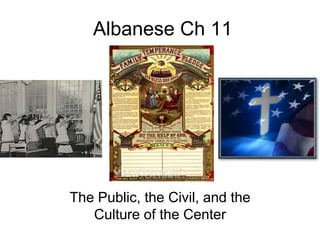
Ch 11 civil religion today
- 1. Albanese Ch 11 The Public, the Civil, and the Culture of the Center
- 2. Part Four: Oneness? • Religion necessary for national unity? • The American Experiment • Who is an “American”? • When does an immigrant become “American”? • Public Protestantism • Civil Religion
- 4. Public Protestantism “The majority tradition acted in subtle and not-so-subtle ways to wear away the sharp edges of separateness and to bring people toward itself….Public Protestantism has meant acknowledged ways of thinking and acting supported by most institutions in society” (Albanese, 257).
- 5. Influential Roots • Puritan school books • Anglican establishment in South • Puritans in New England and Pennsylvania • Colonial governments • “Fit” between this-worldly ethic and taming a wilderness • Material progress and industrial efficiency • Success as God’s blessing • Perfect for a developing nation
- 6. Adaptation • Reform Jews move Sabbath to Sunday • Catholics after Vatican II adopt a quick version of Mass • Mormons and Adventists similar in optimism • Japanese Buddhists form a church (BCA) • Middle class African Americans gravitate towards denominations similar to mainline • Asians convert to Christianity and form their own churches
- 7. The Protestant Code • Religious liberty • Democratic equality • Separation of church and state • Denominationalism • Voluntaryism • Activism • Reductionism • Anti-intellectualism • Ahistoricism • Moralism (jeremiads)
- 8. The Protestant Cultus • Revivals • Preaching • Conversion
- 9. The Protestant Creed • Individualism – Independence – Thrift – Industry – perseverance • Higher (Divine) Law • Millennialism – Pre- (pessimism) – Post- (optimism) • Perfectionism • Manifest Destiny
- 10. Civil Religion Religious system related to the state Theocracy? Attempt to create a nation- state based on: – English Puritanism – Enlightenment ideals – Symbols from U.S. history How meaningful is this?
- 11. Civil Religion in Historical Perspective • Revolution • Constitution • George Washington • Declaration of Independence • Fourth of July • Novus ordo seclorum • Memorial Day Parades • Pledge of allegiance • Battle Hymn of the Republic
- 12. Structure of Civil Religion • Creed: “chosenness” and “millennialism” to be an example of democracy and to spread it to others. • Code: voting, activism, public service • Cultus: Washington and Lincoln Monuments, Mount Rushmore, Mount Vernon, Independence Hall in Philly, Parades, Fireworks, etc., etc. • Community: citizenship based on natural rights
- 13. Civil Religion into the Present • Decline after WWII • Robert Bellah’s The Sacred Canopy (1967) • Sidney E. Mead’s The Lively Experiment (1963) • Will Herberg’s Protestant Catholic Jew (1955) • The American Way of Life • The American People • “One Story” consensus narrative • Does it work anymore?
- 14. Cultural Religion Based on the familiar features of American life established after the Civil War: organized sports, industrialization and corporations, immigrants, new technologies, novels, musicals, movies, etc. 1. The American Ritual Calendar 2. American Sacred Stories 3. American Codes of Living
- 15. American Ritual Calendar • Halloween • Veteran’s Day • Thanksgiving • New Year’s Eve • Martin Luther King, Jr. • President’s Day • Memorial Day • Flag Day/Fourth of July • Valentine’s Day • Mothers/Fathers Days
- 16. American Sacred Stories • The good side will win • The captive will be rescued • Criminals will get justice • Trouble in paradise • Justice through righteous violence • Sacrifice of personal needs • Suffering hero • redemption
- 17. American Codes of Living They provide guidelines and often come along with their own “sacred” stories, “ritual” events, and “saints”…. Self- reinforcing sub-cultures (ideologies, sentiments, beliefs, values) that can substitute for or add to religious experience in America: 1.Sports 2.Technology 3.Popular Psychology 4.Ideas of Nature
- 18. 1. Sports • Training for the ‘game of life’ – Conflict – Winners and loosers – Teamwork – Rules of the game – Being a ‘good sport’
- 19. 2. Technology • Body as machine • Corporate bureaucracies – Efficiency – Non-emotional (no drama!) – Uniformity – Standardization – Consumerism • People and “positions” are expendable • Complex world made “simple” by automation • Transhumanism: Religion of Technology
- 20. 3. Popular (Pop-) Psychology • Human Potential Movement • Humanistic Psychology • Self-Actualization • Therapy, Retreats, Encounter Groups • New Age Religion • Self-help books, Recovery
- 21. 4. Nature • Wilderness as extraordinary encounter • Emphasis on health, simplicity, ecology, conservation • Romantic Naturalism • Eco-Psychology • Outward Bound programs
- 22. Afterthoughts and Overview • A “community of feeling”? • Cultural religion is about the middle class • Public Protestantism’s influence declining • But still significant as Civil Religion • And as Cultural Religion – Public and Private – Ordinary and Extraordinary – When ethnic or organized religions fail, cultural religion will pick up the slack*** • “In America, many religious centers meet, with the one religion competing, finding allies, and combining with the many in a variety of ways” (Albanese, 281).
